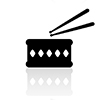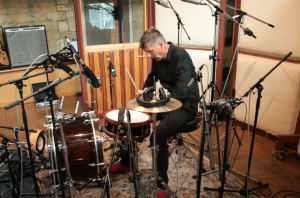Stereo vs. Mono – More than just Twice As Nice
 Asked how many ears you’d prefer most people would obviously say two so why are so many people still connecting their beautiful sounding, stereo instruments with one output in mono?
Asked how many ears you’d prefer most people would obviously say two so why are so many people still connecting their beautiful sounding, stereo instruments with one output in mono?
I suspect it’s a case of not knowing what they’re missing?
In order for the human brain to detect the position of a sound in a space, stereoscopic hearing is required. The difference in time, amplitude and phase of the signal reaching each ear at slightly different times is crucial information used by the brain to determine the location of the source of the sound.
By Simon Ayton
This stereo sound position relationship is very similar to how the brain uses our two-eyed stereo vision to determine an objects location. Holding a finger out in front of you, try to touch it with one eyed closed. You’ll find it’s much easier with a full 3D depth of field to grab it with both eyes open.
 Instruments too have their particular position in the sound-field which we use to identify the size and configuration of the instruments making the sound and if it’s real or a recording. Sitting at a piano, it’s obvious that the sound is spread from left to right across the keyboard from the lowest key to the highest based on the fact that that there is a mechanical sound of pressing the key and the beater hitting the string in that position.
Instruments too have their particular position in the sound-field which we use to identify the size and configuration of the instruments making the sound and if it’s real or a recording. Sitting at a piano, it’s obvious that the sound is spread from left to right across the keyboard from the lowest key to the highest based on the fact that that there is a mechanical sound of pressing the key and the beater hitting the string in that position.
 With a drum kit, which is actually a collection of several percussion instruments grouped together in a ‘kit’, the sounds vary quite dramatically in position for the player. The bass drum sound tends to come from beneath the stool out the front of the kit whereas the snare is dramatically in your face. The ride cymbal off to one side likewise the toms cymbals and hi-hat. For the audience, the difference is less dramatic depending on the distance from the kit but position still has a big impact on what sounds real to the viewer and allows them to connect with what you’re doing up there on stage.
With a drum kit, which is actually a collection of several percussion instruments grouped together in a ‘kit’, the sounds vary quite dramatically in position for the player. The bass drum sound tends to come from beneath the stool out the front of the kit whereas the snare is dramatically in your face. The ride cymbal off to one side likewise the toms cymbals and hi-hat. For the audience, the difference is less dramatic depending on the distance from the kit but position still has a big impact on what sounds real to the viewer and allows them to connect with what you’re doing up there on stage.
 The way the instrument is programmed is designed to reflect the real instrument right down to the position of the sounds. Using a mono connection out of the electronic instrument will give the impression of sound coming from a single position so watching someone playing a drum kit for example will no longer make sense with what the eyes are seeing and negate all the effort that’s gone into creating the sound for the instrument in the first place. The drummer is playing the hi-hat which is on their left if right handed and the floor tom on their right but if the sound is coming from the centre there is now a conflict. Another big issue from a technical point of view is that it’s much harder for the sound technician to create a clear mix when every instrument is sitting in the same position in a mono sound field. Imagine a forest where all the trees are in line. You’d see the first tree but none of the others. Hardly what you’d call a forest full of trees!
The way the instrument is programmed is designed to reflect the real instrument right down to the position of the sounds. Using a mono connection out of the electronic instrument will give the impression of sound coming from a single position so watching someone playing a drum kit for example will no longer make sense with what the eyes are seeing and negate all the effort that’s gone into creating the sound for the instrument in the first place. The drummer is playing the hi-hat which is on their left if right handed and the floor tom on their right but if the sound is coming from the centre there is now a conflict. Another big issue from a technical point of view is that it’s much harder for the sound technician to create a clear mix when every instrument is sitting in the same position in a mono sound field. Imagine a forest where all the trees are in line. You’d see the first tree but none of the others. Hardly what you’d call a forest full of trees!
Many front-of-house (often called F.O.H) live mixing consoles have several stereo channels with a single fader designed to take both the left and right channels from your instrument but if not then simply connect the left and right channels of your instrument to two separate mono channels of the console and use the ‘PAN’ control (which means ‘panorama’ ahhh! Now it’s making sense?) to pan one channel to the far left and the other to the far right.
 The sound will instantly become more spacious-uncluttered, instruments will have their own position in the mix and more importantly, the audience will feel more engaged with the music. Try it and you won’t look back!
The sound will instantly become more spacious-uncluttered, instruments will have their own position in the mix and more importantly, the audience will feel more engaged with the music. Try it and you won’t look back!
See the article ‘Sounds Better in Stereo’ from our Articles section here





